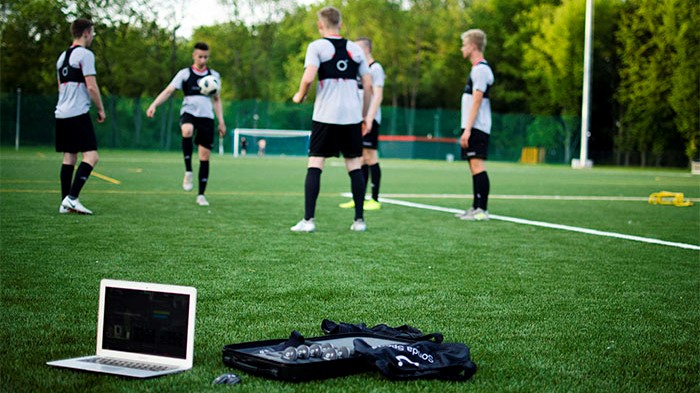Introduction
GPS devices are now widely used across most team sports at all levels, providing coaches and sports scientists with data instantly, allowing for real-time adjustments and long-term performance tracking. However, with such a vast array of data available, it can be difficult for coaches to determine the key metrics that help to inform their training practices.
Setanta founder Dr Liam Hennessy speaks about finding the middle ground between the practitioner and scientist, “drawing both together such that we now call this mid-ground the craft of coaching in sport or in human performance – informed by both practice and science.”
In the below article, Dr Damien Young analyses the key metrics in GPS and how coaches can effectively utilise GPS in the coaching process.
Key GPS Metrics
GPS units worn by players collect information about the player’s position multiple times every second. To make sense of this information, GPS companies use their software to organise the data under different labels, or what is frequently known as metrics. There are hundreds of metrics available across all GPS companies. While it would be impossible to present all here, some of the most frequently used metrics are included below.
- Total Distance
- Distance Per Minute
- Distance at Each Speed Zone
- High-speed running and sprint distance per minute
- The number of sprints
- Length of Sprint
- Maximum Speed
- Acceleration
- Deceleration
- Maximal Intensity Period
The Coaching Process
As indicated by Franks et. al, the coaching process involves several stages. It is a useful model to understand how the match performance is linked to training and how training is linked to the match performance. Ultimately, training and preparation should revolve around the match performance. Below, each stage of the process is outlined, along with the role of GPS at each stage.
Match Performance Observation
Firstly, the match takes place, and the player performs. The more that we know about the performance the better we can prepare the players for it. During a match, coaches observe players and make mental notes on their performance. However, studies have shown that coaches remember less than 50% of key performance indicators. GPS technology supplements these observations by providing objective data on players’ physical outputs, such as the distance covered, speed, and intensity of movements.
Performance Analysis
After the match, GPS data is analysed to answer critical questions about the players’ physical demands:
To analyse the match performance, we can look at:
- How much, how fast, how often
- The differences between positions
- How the running performances change over the season and the match
- The role of substitutions
Relating to Past Performance
To provide a comprehensive analysis, GPS data from recent matches is compared with historical data. This comparison helps identify trends in performance, monitor players’ development, and detect any potential issues such as fatigue or overtraining.
Planning Training Sessions
Utilising these detailed insights, coaches can tailor training sessions to ensure they are in keeping with the match demands. For example, data on high-speed running will allow coaches to replicate these high intensity conditions.
Performing the Training
By using GPS during sessions, coaches can monitor player performance in real-time. This live GPS feedback allows coaches to adjust the intensity and volume of training throughout, ensuring players are neither undertrained or overworked.
Practical Applications and Benefits
Simulating Match Conditions
Training sessions can be designed to mimic the physical demands of a match. For example, small-sided games can be used to replicate the running demands of a full match. GPS data helps ensure that these training activities are achieving the desired intensity and volume, preparing players adequately for match day.
Integrated Conditioning
Integrated conditioning combines physical conditioning with skill practice and small-sided games. GPS quantifies the physical performance during these sessions, ensuring that players achieve the desired volume and intensity. If necessary, additional conditioning can be added based on real-time GPS data.
Identifying Match Demands
Understanding the physical demands of matches is crucial for effective training. GPS data helps answer questions like:
- How much distance is covered by players in different positions?
- What are the high-speed running and sprinting demands?
- How do these demands vary between different phases of the game?
For instance, research has shown that in Gaelic football, players cover greater distances and engage in more high-speed running during key matches like quarter-finals and semi-finals compared to games played earlier in the championship (Mangan, et al. 2019). This knowledge can inform training plans, ensuring players peak at the right time of the season.
Managing Player Workload
Collecting and analysing GPS data is essential for managing player workload, preventing overtraining, and reducing the risk of injuries. By monitoring metrics such as high-speed running, coaches can ensure that players are completing enough to maintain their fitness levels without overtraining.
Conclusion
The integration of GPS technology in team sports supports performance monitoring and analysis, providing coaches with precise, real-time data to help enhance training, manage player workloads, and reduce the risk of injuries. This balanced approach combines scientific insights with practical coaching, enabling tailored training environments that mimic match conditions and optimise player performance. By aligning GPS use with the coaching process, coaches can ensure they are identifying meaningful and impactful metrics to support training practices and ultimately, match performance.

